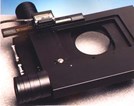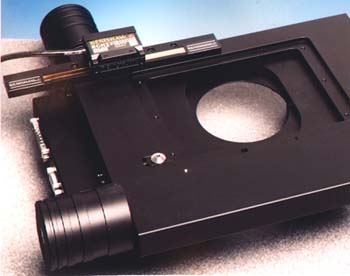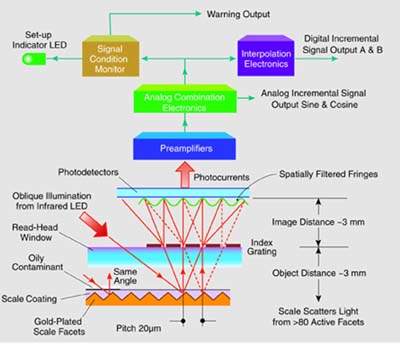Tape Scale and Optoelectronics Beef Up Renishaw Encoder

This "open" linear encoder is designed for high-speed, non-contact position feedback tasks.
Speed with resolution and reliability. A combination that leads to solid performance and flexibility. The new miniature optical linear encoder – called the RG2 – is designed to provide those important benefits in a variety of applications. This device from Renishaw Inc. (Schaumburg, IL) can be easily integrated into measuring machines, linear motors and actuators, X-Y stages, microscopic stages, pick-and-place equipment as well as long machine tool axes to provide high-speed, non-contact position feedback.
The friction-free encoder uses a variety of readheads — some as small as 10.7 mm high and handling speeds to more than 5m/sec. The range of available readheads provides resolutions of 0.1–5 microns.

The universal component of the RG2 system — and key to its accuracy — is a self-adhesive, reflective optical scale that follows the thermal expansion behavior of the underlying material to eliminate differential expansion. It can be used with myriad readheads capable of different signal types and resolutions.
The scale consists of a faceted, gold-plated, steel strip with 20-micron pitch specially coated to protect against routine handling and contamination. When the 6-mm wide, 0.2-mm thick strip is applied directly to a machine and clamped with epoxy-applied fasteners, the ends will shift substantially less than a micron, even over a 0–70°C temperature cycle, whether on aluminum or invar.
The adhesive backing can provide superior shear strength and resistance to oils and many solvents. It bonds to all common materials, including granite and ceramic. Factory-calibrated to ensure linearity and accuracy of ±3 microns/m (actual linear accuracy typically falls within ±1.5 micron/m), the scale can be cut to lengths as short as 10 mm or can be supplied on 50 m reels. Axes as long as 70 m can be accommodated.
How the RG2 Works
The RG2's non-contact readheads, which can be interchanged for better resolution at any time, house an infrared LED light source, index grating, optics, patented photodetectors, set-up indicator, and other electronics.
Unlike conventional scales, which counts pitches by "shuttering" a light source, the RG2 readhead casts infrared light obliquely over a small section of the scale and uses the reflected light. The LED projects light onto more than 100 scale facets, which scatter it back to the readhead onto a transparent phase grating. The combined effect of the scale's periodic pattern and that of the grating produces sinusoidal interference fringes on photodetectors in the readhead.
Electronics in the head convert the photodetector signals into two true pure sinusoidal waveforms of equal amplitude, 90° phase shifted. The result? Cyclical errors typically below 0.1 micron, even when there is scale damage or head misalignment. Patented optics ensure negligible deviation from the 90° phase shift, for superior quadrature control and fast, accurate operation with a range of standard counters.

In an analog output readhead, the sine waves become the 20-micron sine and cosine incremental signals, either in voltage or microcurrent form. The analog-voltage readheads produce a two-channel, 1 Vpp differential, sinusoidal signal for remote interpolation and are capable of speeds over 5 m/sec. Microcurrent readheads generate a two-channel sinusoid signal in quadrature and are capable of 1 m/sec.
Where appropriate, the signals are fed to internal or external interpolation electronics. The interpolator generates two digital quadrature squarewaves, the A and B incremental signals. The RG2's digital-quadrature readheads produce an A/B quadrature (RS-422) signal at resolutions of 0.1, 0.5, 1, and 5 microns, with speeds up to 5m/sec. These are output in differential form for RFI immunity.
Patented Optoelectronics
A novel feature of the scale and optics is that no single scale facet is critical for signal integrity. The system averages the reflection from more than 80 facets and filters out signals that don't match the scale period before the photodetectors convert them to electric currents. This ensures signal accuracy and stability, even when the scale has significant contamination or damage. The internal optics are, in fact, capable of speeds of 7 m/sec or faster and require appropriate counter/controller clock speeds to handle incoming signals.
The optical arrangement also allows a relatively large separation between the scale and readhead (0.8 mm, ±0.11 mm).
Maintaining Accuracy
Two-point linear error compensation is all that's needed to achieve scale accuracy of ±3 microns/m. That is, the readout for an installed length of scale must be compared with a known measurement standard and the resulting compensation value applied, via the control, to future measurements. According to the company, accuracy can be enhanced by using more compensation points and reducing the distance between them. The maximum slope compensation for any uncorrected, one-meter length of scale is less than ±40 microns, typically around ±20 microns.
Simplifying Installation
Installing the RG2 is simple, largely because of the LED setup indicator on the heads. A built-in signal condition monitoring circuit drives an integral, two-color LED and can provide an alarm signal for remote monitoring at the user interface. The circuit continuously monitors the amplitude of the sine and cosine signals before interpolation and controls the LED setup indicator, which shows green to indicate optimum signal, orange for acceptable, and red for a warning condition. Although red does not mean failure, it does indicate a strong possibility of a miscount. The LED is used during initial readhead setup to achieve optimum alignment, thereby eliminating the need for a specialized setup and test kit.
During installation, the readhead is simply swept up and down the scale, and, ideally, should show green all the time. The color of the LED can be affected by speed, alignment of the readhead with the scale, or contamination on the scale. For alignment purposes, ride height and yaw are the most important tolerances.
The scale applicator has the same mounting configuration as a readhead; thus, it simply substitutes in the readhead mounting bracket during lay-down of the scale. The applicator ensures the scale is laid parallel to the axis guideway. The only requirement is a clean, dry surface. End clamping of the scale is highly recommended to ensure zero differential movement between the scale and machine under all thermal conditions.

Advantages of the RG2 system
Following is a list of additional benefits.
• Non-contact operation for indefinite, high-speed operation without lip seals, friction, or hysteresis.
• Compact, low-mass unit is suitable for linear motor integration. All models in the series have very low profiles. The ultra-low RGH25, for example, measures 36 x 14 x 10.7 mm and weighs about 9 g (0.3 oz).
• High ride-height. The readhead has generous working clearances. When installed to the manufacturer's specifications (a bracket for independent adjustment is recommended), standoff is 0.8 mm with a tolerance of ±0.1 mm. Yaw is 0 ±0.5°, roll 0° ±1° and pitch 0° ±1°.
• LED indicator and analog alarm. Patented, built-in LED setup indicator and backup analog alarm ensure ease of installation and reliable operation. No complicated alignment, drilling, or setup of track/sections. Machining and inserts are unnecessary and, with a clean, flat surface, the scale self-adheres to the material of choice. The scale applicator ensures parallelism with the axis guideway.
• Optical system with differential line driver output for high EMI/RFI immunity. Magnetic fields from linear motors cannot disrupt operation. A custom-designed, double-shielded, and highly flexible robotic cable provides both EMI/RFI noise immunity and reliability. The cable has a flex life of greater than10 x 166 at 25-mm bend radius. Readheads are also available with a JST connector for OEM integration.
• Contamination resistance. Infrared light-scattering technology and averaging mean fingerprints, dust, or smears on the scale will not totally disrupt the signal. Scale surface contamination may reduce signal strength, but not affect measuring accuracy. However, the system should not be used in the presence of coolants, oils, or extreme humidity. The scale surface can be wiped clean with a dry cloth or IPA alcohol.
• Six signal formats with reference marking. Analog 1 Vpp voltage, microcurrent, and digital quadrature (RS-422) with resolutions of 0.1, 0.5, 1 and 5 microns.
• Flexible/upgradable system. One scale functions with any readhead, allowing quick field upgrades or changes in system configuration. The user cuts the scale to length.
Additional System Components
The RG2 optical encoder also includes these system components:
• unidirectional reference marks synchronized with the incremental channels and repeatable to the unit of resolution for a given readhead.
• epoxy-mounted scale end-clamps that can be used at the designer's discretion, depending on the length of the scale, accuracy requirement, and thermal management of the machine structure. The ultra-low-profile clamps (0.2 mm) fit beneath the readhead so that overtravel or removal does not disturb the scale.
• scale applicator that slips into the readhead mounting bracket during installation and, while stripping off the backing tape, automatically lays the scale parallel to the axis.
For more information, contact Renishaw Inc., 623 Cooper Ct., Schaumburg, IL 60173. Tel: 847-843-3666.
